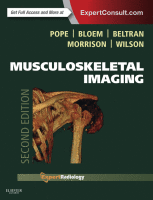Physical Address
304 North Cardinal St.
Dorchester Center, MA 02124

Fractures of the pelvic ring and acetabulum are a common consequence of high-speed collisions, usually related to motor vehicle accidents. They may also be caused by minor falls and occupational accidents. These injuries are associated with significant morbidity and mortality,…

Technical Aspects Techniques and Relevant Aspects Conventional Radiography Rationale and Indications For visualization of osseous anatomy and pathology, bone contours, and joint alignment. Recommended for any primary evaluation of suspected hip pathology, including fractures, dislocations, bone tumors, and infection. Gluteal,…

Hand and wrist pain and restricted movement are common disabling complaints that may be caused by a broad spectrum of soft tissue disorders. These injuries may be the result of a single incident, such as falling on an outstretched hand,…

Upper Extremity Shoulder Suprascapular Nerve Syndrome Impingement of the suprascapular nerve occurs at the scapular notch or spinoglenoid notch. The suprascapular nerve originates from the brachial plexus, and at the scapular notch it branches into the supraspinatus and infraspinatus nerves…

Prevalence, Epidemiology, and Definitions Acute bony trauma to the hand represents some of the most commonly occurring fractures encountered in daily clinical practice. Whether the etiology is related to sports, occupation, or trauma, the consequences can be devastating and the…

Introduction Wrist anatomy and function is both complex and detailed. Evaluation for internal derangement assumes an understanding of the anatomy, imaging characteristics, biomechanics, and function of key ligaments and cartilaginous structures in the wrist, including the triangular fibrocartilage complex (TFCC),…

Prevalence, Epidemiology, and Definitions Acute osseous injury to the wrist may be encountered in a subject who has received direct trauma to the wrist or who has fallen on the outstretched hand (popularly referred to as FOOSH). Radiographic evaluation remains…

Normal Wrist Technical Aspects Conventional Radiography Rationale and Indications Allows visualization of osseous anatomy and pathology, bone contours, and joint alignment Is recommended for any primary evaluation of osseous wrist pathologic processes such as fractures, dislocations or malalignment, infection, and…

Prevalence, Epidemiology, and Definitions Musculotendinous Injury Traumatic injury to the musculotendinous units of the elbow may result from acute trauma or repetitive micro-trauma. Furthermore, acute trauma is frequently superimposed on tendinopathy or other chronic injuries. MRI can be highly valuable…

Anatomy (Including Gross Anatomy and Normal Variants) Fat Pads The anterior fat pad is anterior to the olecranon fossa and is routinely seen on the normal lateral view, extending inferior, from the anterior humeral cortex, obliquely. The posterior fat pad…